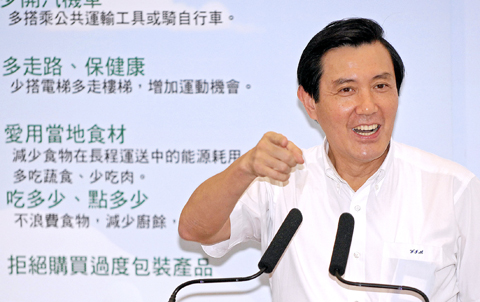On World Environment Day yesterday, nuclear power was listed as an option for the government’s carbon-free energy program as the Cabinet approved sustainable energy policy guidelines.
The move indicated that the new Chinese Nationalist Party (KMT) administration will run counter to the statutory goal of establishing a “nuclear-free homeland,” which the former Democratic Progressive Party (DPP) government pushed through in the Environment Basic Law (環境基本法) in 2002.
Yeh Huey-ching (葉惠青), the director-general of the Ministry of Economic Affairs’ (MOEA) Bureau of Energy, which drew up the draft guidelines, sidestepped that question, saying that “problems related to nuclear power require further deliberation.”

PHOTO: SAM YEH, AFP
Asked about the government’s position on the nation’s three nuclear power plants and the new Fourth Nuclear Power Plant, Yeh said: “We intend to use every means available to reduce carbon emissions. [Nuclear] is the last option to be considered, the last choice.”
Premier Liu Chao-shiuan (劉兆玄) issued a directive at yesterday’s Cabinet meeting to speed up the completion of the Fourth Nuclear Power Plant, to find the best solution to handle nuclear waste and to better communicate with the public about the nuclear power issue, Yeh said.
Yeh said that the percentage of the nation’s electricity derived from nuclear power would not be determined until a planned national energy conference in the latter half of the year.
Currently nuclear power generates 17 percent of Taiwan’s electricity.
Taiwan was the first country in Asia to announce a plan to build a “nuclear-free homeland” when it introduced the law in 2002, a joint decision by the KMT and DPP that sought to end the political standoff that arose from the DPP’s decision in 2000 to halt the construction of the Fourth Nuclear Power Plant.
The plant is scheduled to go on-line late next year.
Based on the law, the former DPP government established a Nuclear-Free Homeland Promotion Commission to publicize the policy and had the MOEA draw up a statute to bring forward the phasing out of the three existing nuclear power plants.
Under its sustainable energy policy guidelines, the KMT administration has vowed to pursue energy efficiency, clean energy and energy stability to create a “win-win-win” situation for energy production, the environment and economic growth.
In terms of energy efficiency, energy intensity — a measure of energy consumption per GDP — should be cut by 20 percent below 2005’s levels by 2015 and further lowered to 50 percent below those levels by 2025, the guidelines said.
The government would be required to increase the percentage of electricity generated by low-carbon fuel to 55 percent of the nation’s requirements by 2025 from the current level of 40 percent and the energy generated by renewable carbon-free sources from the current level of 5 percent to 8 percent by 2025.
“These are all demanding objectives,” Yeh said.
Yeh said that the government would push for the passage of regulations that aim to reduce carbon dioxide emissions, encourage renewable energy production and impose an energy tax.

The disruption of 941 flights in and out of Taiwan due to China’s large-scale military exercises was no accident, but rather the result of a “quasi-blockade” used to simulate creating the air and sea routes needed for an amphibious landing, a military expert said. The disruptions occurred on Tuesday and lasted about 10 hours as China conducted live-fire drills in the Taiwan Strait. The Civil Aviation Administration (CAA) said the exercises affected 857 international flights and 84 domestic flights, affecting more than 100,000 travelers. Su Tzu-yun (蘇紫雲), a research fellow at the government-sponsored Institute for National Defense and Security Research, said the air

Taiwan is to commence mass production of the Tien Kung (天弓, “Sky Bow”) III, IV and V missiles by the second quarter of this year if the legislature approves the government’s NT$1.25 trillion (US$39.78 billion) special defense budget, an official said yesterday. Commenting on condition of anonymity, a defense official with knowledge of the matter said that the advanced systems are expected to provide crucial capabilities against ballistic and cruise missiles for the proposed “T-Dome,” an advanced, multi-layered air defense network. The Tien Kung III is an air defense missile with a maximum interception altitude of 35km. The Tien Kung IV and V

Trips for more than 100,000 international and domestic air travelers could be disrupted as China launches a military exercise around Taiwan today, Taiwan’s Civil Aviation Administration (CAA) said yesterday. The exercise could affect nearly 900 flights scheduled to enter the Taipei Flight Information Region (FIR) during the exercise window, it added. A notice issued by the Chinese Civil Aviation Administration showed there would be seven temporary zones around the Taiwan Strait which would be used for live-fire exercises, lasting from 8am to 6pm today. All aircraft are prohibited from entering during exercise, it says. Taipei FIR has 14 international air routes and

Taiwan lacks effective and cost-efficient armaments to intercept rockets, making the planned “T-Dome” interception system necessary, two experts said on Tuesday. The concerns were raised after China’s military fired two waves of rockets during live-fire drills around Taiwan on Tuesday, part of two-day exercises code-named “Justice Mission 2025.” The first wave involved 17 rockets launched at 9am from Pingtan in China’s Fujian Province, according to Lieutenant General Hsieh Jih-sheng (謝日升) of the Office of the Deputy Chief of the General Staff for Intelligence at the Ministry of National Defense. Those rockets landed 70 nautical miles (129.6km) northeast of Keelung without flying over Taiwan,